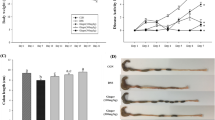Abstract
Ozone is one of the most powerful oxidants available, with many applications in industry and medicine. Medically relevant features of ozone include bacterial and virucidal properties, disinfection, sterilization, circulatory stimulation, and disruption of malignant cells. Ozone therapy is administered in various ways, including intravenously, intramuscularly, and intrarectally. The latter modality is used for the treatment of colitis and hepatitis. Our aim was to examine the effect of ozone water enema on normal and inflamed rat colonic mucosa. Ozone water (20 μg/ml) was prepared via ozone generator and administered intrarectally (0.5 ml) daily. Rats were killed one, three, and seven days after rectal ozone water administration, and their colons resected, rinsed, and weighed (grams per 10 cm). Damage was assessed macro- and microscopically and tissue processed for myeloperoxidase and nitric oxide synthase activity. Rats receiving saline served as controls. In an additional experiment colitis was induced by intrarectal iodoacetamide. Ozone therapy caused no macroscopic damage. Ozone therapy induced microscopic colitis, which lasted for at least a week and was accompanied by increase in segmental weight, myeloperoxidase and nitric oxide activity, and prostaglandin E2 generation. Ozone therapy had no protective effect on inflamed mucosa. In conclusion, ozone water therapy had a deleterious effect on normal colonic mucosa, suggesting intrarectal administration be reevaluated. Ozone water enema may serve as a model of microscopic colitis.
Similar content being viewed by others
REFERENCES
Schulz S: The role of ozone/oxygen in clindamycin-associated enterocolitis in the Djungarian hamster (Phodopus sungorus sungorus). Lab Anim 20:41–48; 1986
Menzel DB: Ozone toxicity in man and animals. J Toxicol Environ Health 3:183–189, 1984
Fundamental biochemical, clinical and technical elements of ozone/oxygen therapy. Brochure. IOA, pp 13–85 1978
Knoch HG, Klug W: Ozone/oxygen therapy in proctology. Ter Arkh 6:93–8, 1990
Garcia-Laafuente A, Antolin M, Guarner F: Incrimination of anaerobic bacteria in the induction of experimental colitis. Am J Physiol 272:G10–G15, 1997
Rath HC, Herfarth HH, Ikeda JS: Normal luminal bacteria, especially bactericides species, mediate chronic colitis, gastritis, and arthritis, in HLA-B27/human beta-2 microglobulin transgenic rats. J Clin Invest 98:945–953, 1996
Waaser GH: Behandlung von veletzungen mit ozonisierten wasser. Ozone Handbuch. Ecomed, 1995, V-7.4.
Rakness K, Gordon G, Langlais B, Masschelein W, Matsumoto N, Richard Y, Robson CM, Somiya I: Guidelines for measurement of ozone concentrations in the process gas from an ozone generator. Ozone Sci Eng 18: 209–229, 1996
Eliakim R, Karmeli F, Cohen P, Rachmilewitz D, Shao JS, Alpers DH: Sulfhydryl blocker-induced rat colitis is ameliorated by intravenous injection of antibody to colonic surfactant-like particle. Inflamm Bowel Dis 5:16–23, 1999
Bush PA, Gonzalez NE, Griecavage JM, Ignano LI: Nitric oxide synthase from cerebellum catalyzes the formation of equimolar quantities of nitric oxide and citrulline from Larginine. Biochem Biophys Res Commun 185:960–966, 1992
Bradley PP, Priebal DA, Chritensen RD, Rolhatien G. Measurement of cutaneous inflammation. Estimation of neutrophil content with an enzyme marker. J Invest Dermatol 78:206–209, 1982
Sharon P, Ligumsky M, Rachmilewitz D, Zor U: role of prostaglandins in ulcerative colitis. Enhanced production during active disease and inhibition by sulphasalazine. Gastroenterology 75:638–640, 1978
Schierhorn K, Zhang M, Kacy M, Kunkel G. Ozone-induced augmentation of eicosanoid metabolism in human nasal mucosa in vitro. Int Arch Allergy Immunol 113:312–315, 1997
Laskin DL, Heck DE, Laskin JD: Role of inflammatory cytokines and nitric oxide in hepatic and pulmonary toxicity. Toxicol Lett 102-103:289–293, 1998
Pendino KJ, Shuler RL, Laskin JD, Laskin DL: Enhanced production of interleukin-1, tumor necrosis factor-alpha and fibronectin by rat lung phagocytes following inhalation of a pulmonary irritant. Am J Respir Cell Mol Biol 11:279–286, 1994
Kaneko T, Ikeda H, Fu L, Nishiyama H, Okubo T: Plateletactivating factor mediates the ozone-induced increase in airway microvascular leakage in guinea pigs. Eur J Pharmacol 292:251–255, 1995
Zhao Q, Simpson LG, Driscoll KE, Leikauf GD: Chemokine regulation of ozone-induced neutrophil and monocyte inflammation. Am J Physiol 274:L39–L46, 1998
Haddad EB, Salmon M, Barnes PJ, Adcock I, Chung KF: Ozone induction of cytokine-induced neutrophil chemoattractant (CINC) and nuclear factor-kappa b in rat lung: inhibition by corticosteroids. FEBS Lett 379:265–268, 1996
Hiltermann JT, Lapperre TS, van Bree L, Steerenberg PA, Brahim JJ, Sont JK, Sterk PJ, Hiemstra PS, Stolk J: Ozoneinduced inflammation assessed in sputum and bronchial lavage fluid from asthmatics; a new noninvasive tool in epidemiologic studies on air pollution and asthma. Free Radic Biol Med 27:1448–1454, 1999
Inoue H, Aizawa H, Nakano H, Matsumoto K, Kuwano K, Nadel JA, Hara N: Nitric oxide synthase inhibitors attenuate ozoneinduced airway inflammation in guinea pigs. Possible role of interleukin-8. Am J Respir Crit Care Med 161:249–256, 2000
Reinhart PG, Gupta SK, Bhalla DK: Attenuation of ozoneinduced lung injury by interleukin-10. Toxicol Lett 110:35–42, 1999
Rachmilewitz D, Karmeli F, Okon E, Bursztyn M: Experimental colitis is ameliorated by inhibition of nitric oxide synthase activity. Gut 37:247–255, 1995
Barbara G, Xing Z, Hogaboam CM, Gauldie J, Collins SM: Interleukin 10 gene transfer prevents experimental colitis in rats. Gut 46:344–349, 2000
Author information
Authors and Affiliations
Rights and permissions
About this article
Cite this article
Eliakim, R., Karmeli, F., Rachmilewitz, D. et al. Ozone Enema: A Model of Microscopic Colitis in Rats. Dig Dis Sci 46, 2515–2520 (2001). https://doi.org/10.1023/A:1012348525208
Issue Date:
DOI: https://doi.org/10.1023/A:1012348525208




